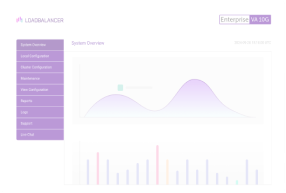Load balancing Citrix Virtual Desktops
Benefits of load balancing Citrix Virtual Desktops
Load balancing Citrix Virtual Desktops provides the following benefits:
- High Availability (HA): Load balancing is critical for eliminating a single point of failure in your Virtual Desktop Infrastructure (VDI). If one Delivery Controller, StoreFront server, or VDI host fails (e.g., due to a crash, maintenance, or being taken offline), the load balancer automatically detects the failure. It immediately redirects all incoming user traffic and session requests to the remaining healthy, available servers. This process is often seamless to the end-user, ensuring continuous access to their virtual applications and desktops.
- Optimal performance and user experience: By intelligently distributing the workload, load balancing prevents any single server from becoming a bottleneck, ensuring a consistent and fast experience for all users. Incoming connections and application launch requests are spread across all active servers based on algorithms (like “least connection” or “least loaded”). This prevents any one server from being overloaded, even during peak usage times. By balancing the processing load, the time it takes for a user to authenticate, log in, and launch their virtual desktop or application is minimized, resulting in a more responsive and positive user experience.
- Scalability and flexibility: Load balancing makes it easier to grow and manage your environment without causing downtime. As your organization grows and the number of users increases, you can easily add new servers (Delivery Controllers or VDI hosts) to the load-balanced group. The load balancer automatically incorporates them and starts directing traffic to them, making the environment highly scalable. Administrators can isolate (take out of service) a single server from the load balancer, perform necessary maintenance (patching, upgrades, configuration changes) on it, and then safely bring it back online. This allows for rolling updates with zero interruption to the users.
About Citrix Virtual Desktops
Citrix Virtual Desktops (formerly Citrix XenDesktops) is a virtual desktop infrastructure (VDI) offering that enables full desktop virtualization.
Citrix XenDesktops was renamed Citrix Virtual Desktops in 2018.
Today, Citrix’s virtualization product suites are Citrix Virtual Apps and Desktops (CVAD) (which Citrix Virtual Desktops forms part of) and Citrix DaaS.
Why Loadbalancer.org for Citrix Virtual Desktops?
Loadbalancer’s intuitive Enterprise Application Delivery Controller (ADC) is designed to save time and money with a clever, not complex, WebUI.
Easily configure, deploy, manage, and maintain our Enterprise load balancer, reducing complexity and the risk of human error. For a difference you can see in just minutes.
And with WAF and GSLB included straight out-of-the-box, there’s no hidden costs, so the prices you see on our website are fully transparent.
More on what’s possible with Loadbalancer.org.
How to load balance Citrix Virtual Desktops
The load balancer can be deployed in 4 fundamental ways: Layer 4 DR mode, Layer 4 NAT mode, Layer 4 SNAT mode, and Layer 7 Reverse Proxy (Layer 7 SNAT mode).
For Citrix Virtual Desktops, using Layer 7 SNAT mode is recommended.
About Layer 7 Reverse Proxy load balancing
Layer 7 Reverse Proxy uses a proxy (HAProxy) at the application layer. Inbound requests are terminated on the load balancer and HAProxy generates a new corresponding request to the chosen Real Server. As a result, Layer 7 is typically not as fast as the Layer 4 methods.
Layer 7 is typically chosen when enhanced options such as SSL termination, cookie based persistence, URL rewriting, header insertion/deletion etc. are required, or when the network topology prohibits the use of the Layer 4 methods.

Because Layer 7 Reverse Proxy is a full proxy, any server in the cluster can be on any accessible subnet, including across the Internet or WAN.
Layer 7 Reverse Proxy is not transparent by default i.e. the Real Servers will not see the source IP address of the client, they will see the load balancer’s own IP address by default, or any other local appliance IP address if preferred (e.g. the VIP address). This can be configured per Layer 7 VIP.
If required, the load balancer can be configured to provide the actual client IP address to the Real Servers in two ways:
- Either by inserting a header that contains the client’s source IP address, or
- By modifying the Source Address field of the IP packets and replacing the IP address of the load balancer with the IP address of the client.
Layer 7 Reverse Proxy mode can be deployed using either a one-arm or two-arm configuration. For two-arm deployments, eth0 is normally used for the internal network and eth1 is used for the external network, although this is not mandatory.
No mode-specific configuration changes to the load balanced Real Servers are required.
Port translation is possible with Layer 7 Reverse Proxy e.g. VIP:80 → RIP:8080 is supported. You should not use the same RIP:PORT combination for Layer 7 Reverse Proxy VIPs and Layer 4 SNAT mode VIPs because the required firewall rules conflict.

















